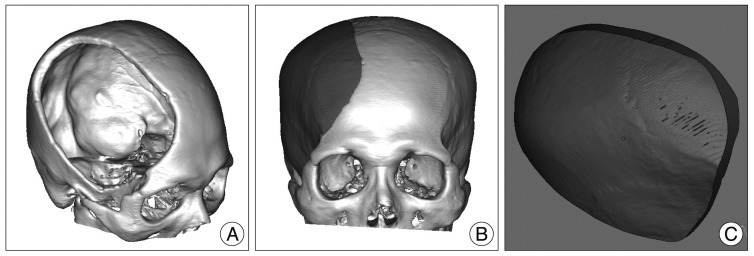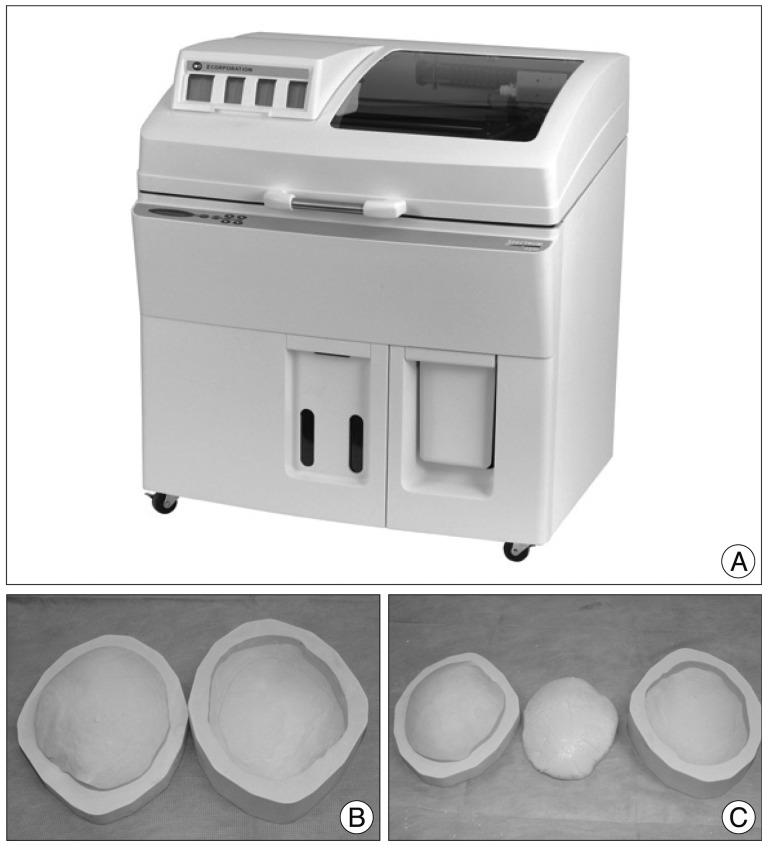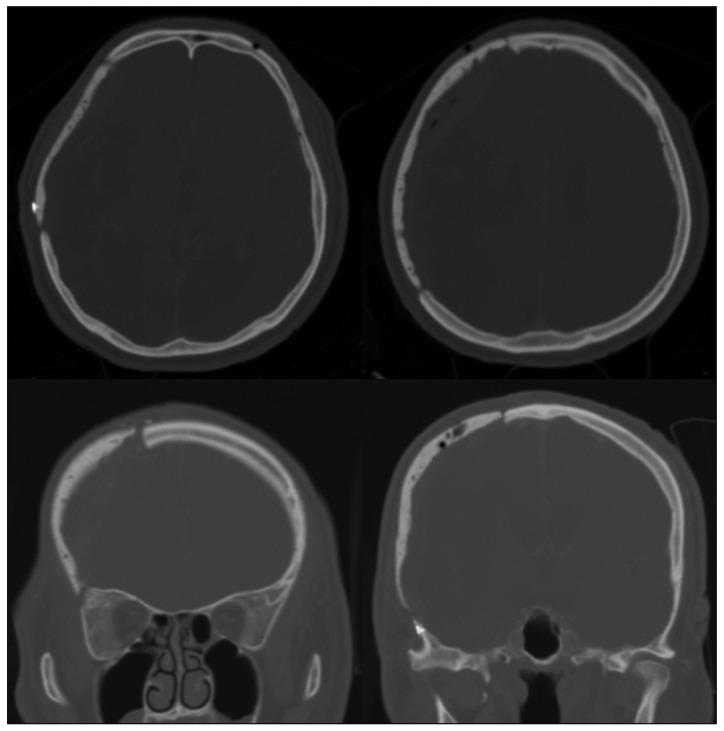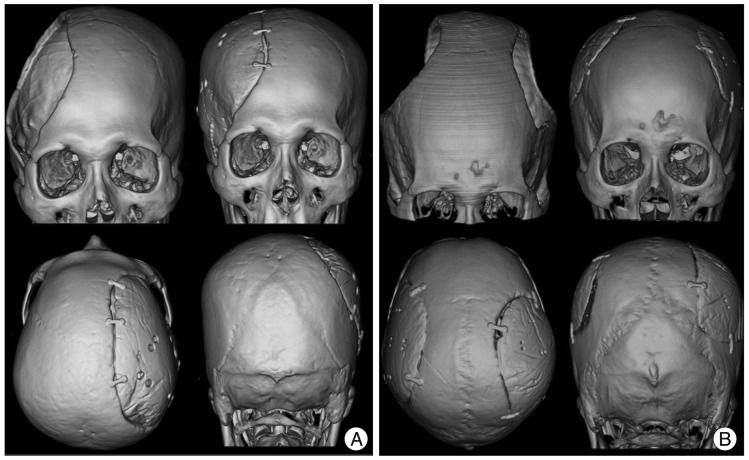J Korean Neurosurg Soc.
2012 Dec;52(6):541-546. 10.3340/jkns.2012.52.6.541.
Customized Cranioplasty Implants Using Three-Dimensional Printers and Polymethyl-Methacrylate Casting
- Affiliations
-
- 1Department of Neurosurgery, Korea University College of Medicine, Seoul, Korea. hermes23@kumc.or.kr
- KMID: 1426264
- DOI: http://doi.org/10.3340/jkns.2012.52.6.541
Abstract
OBJECTIVE
The prefabrication of customized cranioplastic implants has been introduced to overcome the difficulties of intra-operative implant molding. The authors present a new technique, which consists of the prefabrication of implant molds using three-dimensional (3D) printers and polymethyl-methacrylate (PMMA) casting.
METHODS
A total of 16 patients with large skull defects (>100 cm2) underwent cranioplasty between November 2009 and April 2011. For unilateral cranial defects, 3D images of the skull were obtained from preoperative axial 1-mm spiral computed tomography (CT) scans. The image of the implant was generated by a digital subtraction mirror-imaging process using the normal side of the cranium as a model. For bilateral cranial defects, precraniectomy routine spiral CT scan data were merged with postcraniectomy 3D CT images following a smoothing process. Prefabrication of the mold was performed by the 3D printer. Intraoperatively, the PMMA implant was created with the prefabricated mold, and fit into the cranial defect.
RESULTS
The median operation time was 184.36+/-26.07 minutes. Postoperative CT scans showed excellent restoration of the symmetrical contours and curvature of the cranium in all cases. The median follow-up period was 23 months (range, 14-28 months). Postoperative infection was developed in one case (6.2%) who had an open wound defect previously.
CONCLUSION
Customized cranioplasty PMMA implants using 3D printer may be a useful technique for the reconstruction of various cranial defects.
Keyword
MeSH Terms
Figure
Cited by 1 articles
-
Cranioplasty Using Autologous Bone versus Porous Polyethylene versus Custom-Made Titanium Mesh : A Retrospective Review of 108 Patients
Jun-Ki Kim, Sang-Bok Lee, Seo-Yeon Yang
J Korean Neurosurg Soc. 2018;61(6):737-746. doi: 10.3340/jkns.2018.0047.
Reference
-
1. Balossier A, Durand A, Achim VV, Noudel R, Hurel S, Emery E. [Reconstruction of the cranial vault using CAD/CAM-fabricated glass bioceramic implants]. Neurochirurgie. 2011; 57:21–27. PMID: 20870257.2. Chang V, Hartzfeld P, Langlois M, Mahmood A, Seyfried D. Outcomes of cranial repair after craniectomy. J Neurosurg. 2010; 112:1120–1124. PMID: 19612971.
Article3. Dean D, Min KJ, Bond A. Computer aided design of large-format prefabricated cranial plates. J Craniofac Surg. 2003; 14:819–832. PMID: 14600623.
Article4. Dujovny M, Aviles A, Agner C, Fernandez P, Charbel FT. Cranioplasty : cosmetic or therapeutic? Surg Neurol. 1997; 47:238–241. PMID: 9068693.5. D'Urso PS, Earwaker WJ, Barker TM, Redmond MJ, Thompson RG, Effeney DJ, et al. Custom cranioplasty using stereolithography and acrylic. Br J Plast Surg. 2000; 53:200–204. PMID: 10738323.6. Eppley BL, Kilgo M, Coleman JJ 3rd. Cranial reconstruction with computer-generated hard-tissue replacement patient-matched implants : indications, surgical technique, and long-term follow-up. Plast Reconstr Surg. 2002; 109:864–871. PMID: 11884798.
Article7. Fallahi B, Foroutan M, Motavalli S, Dujovny M, Limaye S. Computer-aided manufacturing of implants for the repair of large cranial defects : an improvement of the stereolithography technique. Neurol Res. 1999; 21:281–286. PMID: 10319337.
Article8. Goh RC, Chang CN, Lin CL, Lo LJ. Customised fabricated implants after previous failed cranioplasty. J Plast Reconstr Aesthet Surg. 2010; 63:1479–1484. PMID: 19766072.
Article9. Golz T, Graham CR, Busch LC, Wulf J, Winder RJ. Temperature elevation during simulated polymethylmethacrylate (PMMA) cranioplasty in a cadaver model. J Clin Neurosci. 2010; 17:617–622. PMID: 20189395.
Article10. Gupta R, Connolly ES, Mayer S, Elkind MS. Hemicraniectomy for massive middle cerebral artery territory infarction : a systematic review. Stroke. 2004; 35:539–543. PMID: 14707232.
Article11. Hieu LC, Bohez E, Vander Sloten J, Oris P, Phien HN, Vatcharaporn E, et al. Design and manufacturing of cranioplasty implants by 3-axis cnc milling. Technol Health Care. 2002; 10:413–423. PMID: 12368561.
Article12. Hoffmann B, Sepehrnia A. Taylored implants for alloplastic cranioplasty--clinical and surgical considerations. Acta Neurochir Suppl. 2005; 93:127–129. PMID: 15986741.13. Hong KS, Kang SH, Lee JB, Chung YG, Lee HK, Chung HS. Cranioplasty with the porous polyethylene implant(Medpor) for large cranial defect. J Korean Neurosurg Soc. 2005; 38:96–101.14. Iwama T, Yamada J, Imai S, Shinoda J, Funakoshi T, Sakai N. The use of frozen autogenous bone flaps in delayed cranioplasty revisited. Neurosurgery. 2003; 52:591–596. discussion 595-596. PMID: 12590683.
Article15. Lambrecht JT, Brix F. Individual skull model fabrication for craniofacial surgery. Cleft Palate J. 1990; 27:382–385. discussion 386-387. PMID: 2253385.
Article16. Lee SC, Wu CT, Lee ST, Chen PJ. Cranioplasty using polymethyl methacrylate prostheses. J Clin Neurosci. 2009; 16:56–63. PMID: 19046734.
Article17. Mavili ME, Canter HI, Saglam-Aydinatay B, Kamaci S, Kocadereli I. Use of three-dimensional medical modeling methods for precise planning of orthognathic surgery. J Craniofac Surg. 2007; 18:740–747. PMID: 17667659.
Article18. Morley NC, Berge E, Cruz-Flores S, Whittle IR. Surgical decompression for cerebral oedema in acute ischaemic stroke. Cochrane Database Syst Rev. 2002; CD003435. PMID: 12137695.
Article19. Saringer W, Nöbauer-Huhmann I, Knosp E. Cranioplasty with individual carbon fibre reinforced polymere (CFRP) medical grade implants based on CAD/CAM technique. Acta Neurochir (Wien). 2002; 144:1193–1203. PMID: 12434176.
Article20. Segal DH, Oppenheim JS, Murovic JA. Neurological recovery after cranioplasty. Neurosurgery. 1994; 34:729–731. discussion 731. PMID: 8008174.
Article21. Winter CD, Adamides A, Rosenfeld JV. The role of decompressive craniectomy in the management of traumatic brain injury : a critical review. J Clin Neurosci. 2005; 12:619–623. PMID: 16033709.
Article22. Wulf J, Busch LC, Golz T, Knopp U, Giese A, Ssenyonjo H, et al. CAD generated mold for preoperative implant fabrication in cranioplasty. Stud Health Technol Inform. 2005; 111:608–610. PMID: 15718807.
- Full Text Links
- Actions
-
Cited
- CITED
-
- Close
- Share
- Similar articles
-
- Late seroma and infection in patients with cranioplasty implants after lateral suboccipital craniectomy
- Rehabilitation with implant-supported fixed dental prostheses using digital duplication technique on customized artificial tooth, interim denture and implant surgical template: A case report
- A biomechanical study on diaphyseal defect filled with polymethylmethacrylate
- Cranioplasty with the Porous Polyethylene Implant(Medpor) for Large Cranial Defect
- Large Defect May Cause Infectious Complications in Cranioplasty







